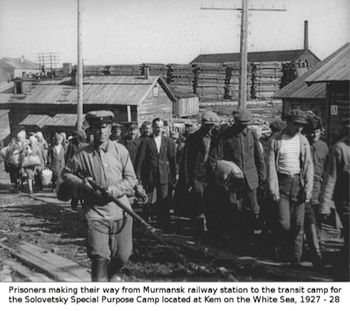

|
The Gulag and Economic Growth  Prisoners on their way to Solovetsky Special Purpose Prison Camp, 1927 The rates of growth that Stalin had demanded in the Five Year Plan could not have been achieved without the use of forced labour, particularly in the cold and remote regions of the far north and Siberia, where so many of the Soviet Union's precious economic resources (diamonds, gold, platinum and nickel, oil, coal and timber) were located but where nobody would freely go. The Gulag was the key to opening up these areas for Soviet industry. Sending millions of prisoners to dig mines and canals, build railways and chop down forests in Arctic zones made an incalculable contribution to the country's economic growth.  Yagoda inspects a Gulag project EXTRACT FOR SUBSCRIBERS ONLY. Orlando Figes, Revolutionary Russia, 1891-1991 (Pelican, 2014), pp. 219-23. The word 'Gulag' is an acronym for the Main Administration of Corrective Labour Camps and Colonies. The Soviet prison system started as a means of isolating 'counter-revolutionary elements'. But with the beginning of the Five Year Plan it became a form of economic colonization... [FULL TEXT 974 WORDS] |
© 2014 Orlando Figes | All Rights Reserved